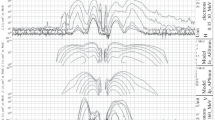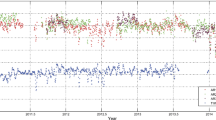Abstract
The errors in measurements of the energy of the reflected solar radiation and the thermal radiation emitted from Earth entering space in all directions from the top of the atmosphere are analyzed. The potentials of measurements onboard the Lunar Observatory (LO) and spacecraft (SC) on geostationary and solar-synchronous orbits and at the L1 Lagrange point of the Sun–Earth system (SEL1) are compared. To take into account the radiation from the edge of the Earth’s disk, which cannot be observed from a geostationary orbiter at all phase angles, theoretical models should be constructed. The intensity distribution of radiation reflected to space through all other directions in dependence on the surface type, the radiation incidence angle, and the observation angle is also modeled. The actual inaccuracy of these methods is approximately 1%. At the SEL1 point, a SC may simultaneously observe the whole surface of the planet only at a phase angle α = 0° and only in the periods when the Moon does not eclipse the Earth’s disk. To take into account the radiation reflected to space at all other phase angles, it is necessary to construct theoretical models. This fact, as well as the lack of observations during lunar eclipses of the Earth, is connected with large errors in the required quantities. The system of two optical robotic telescopes mounted on the LO will sequentially survey the Earth’s surface almost in all ranges of phase angles. The annual averages of the Bond albedo and the emitted thermal radiation of the Earth as a planet determined at the LO and the corresponding deviations of the annual average global energy budget of the planet from the equilibrium state will be almost an order of magnitude more accurate than those determined from the data of any orbiter.



Similar content being viewed by others
REFERENCES
Abdussamatov, H.I., Long-term variations in the integral radiation flux and possible temperature changes in the solar core, Kin. Phys. Celest. Bodies, 2005, vol. 21, no. 6, pp. 328–332.
Abdussamatov, H.I., Bicentennial decrease in the solar constant leads to the Earth’s unbalanced heat budget and deep climate cooling, Kin. Phys. Celest. Bodies, 2012, vol. T. 28, no. 2, pp. 62–68.
Abdussamatov, H.I., Glubokii minimum moschnosti solnechnogo izlucheniya privedet k Malomu lednikovomu periodu (A Deep Minimum of Solar Radiation Intensity Leads to Little Ice Age), St. Petersburg, Nestor-Istoriya, 2013.
Abdussamatov, H.I., Lunar observatory, Program no. 9 of Basic Research of the Presidium of the Russian Academy of Sciences “Experimental and Theoretical Studies Solar System Objects and Stellar Planetary Systems”, Report for 2015, pp. 312–321. http://pr9.cosmos.ru/ sites/pr9.cosmos.ru/files/report2015/9-Gerasimov.pdf.
Abdussamatov, H.I., Lunar observatory for the study of the deviation of the Earth’s energy balance from the equilibrium state and the causes of climate change, Issled. Zemli iz Kosmosa, 2016a, no. 5, pp. 79–88.
Abdussamatov, H.I., The new Little Ice Age has started, in Evidence-Based Climate Science, Easterbrook, D.J., Ed., Elsevier, 2016, ch. 17, pp. 307–328, 2016b. doi 10.1016/B978-0-12-804588-6.00017-3.
Abdussamatov, H.I., Lunnaya observatoriya dlya issledovanii klimata Zemli v epokhu glubokogo pokholodaniya (Lunar Observatory for the Earth’s Climate Studies in the Deep Cooling Period), St. Petersburg: Nauka, 2017a.
Abdussamatov, H.I., Lunar observatory for studying the deviation of the Earth’s energy balance from the equilibrium state and the causes of climate changes, 2017b. http://www.gao.spb.ru/russian/project/lunar_observatory. pdf.
Abdussamatov, H.I., Bogoyavlenskii, A.I., Khankov, S.I., and Lapovok, Y.V., The influence of the atmospheric transmission for the solar radiation and Earth’s surface radiation on the Earth’s climate, J. Geogr. Inf. Syst., 2010, no. 2, pp. 194–200.
Abdussamatov, H.I., Lapovok, Y.V., and Khankov, S.I., Monitoring of the Earth’s energy balance from the Lagrangian point L1, J. Opt. Technol., 2014, vol. 81, no. 1, pp. 18–23.
Abdussamatov, H.I., Lapovok, Y.V., and Khankov, S.I., Influence of the cryosphere and the area of the Earth’s cloud cover on the change in its energy balance and global climate, Vestn. Mezhdunar. Akad. Kholoda, 2015, no. 1, pp. 61–64.
CLARREO, Climate absolute radiance and refractivity observatory, 2017. https://eospso.gsfc.nasa.gov/m-issions/ clima-te-absolute-radiance-and-refractivity-observatory; https://clarreo.larc.nasa.gov/.
DSCOVR, Deep space climate observatory, 2017. https:// www.nasa.gov/feature/goddard/from-a-million-miles-awaynasa-camera-shows-moon-crossing-face-of-earth; https://ru.wikipedia.org/wiki/Deep_Space_Climate_ Observatory.
Earth observatory, Looking at the Moon to better see the Earth, 2017. http://earthobservatory.nasa.gov/IOTD/ view.php?id=90764&src=eoa-iotd.
EOS, The Earth observing system of environmental satellites, 2017. http://www.spacetoday.org/Satellites/TerraAqua/ TerraAquaAura.html.
Exoplanets, Seager, S., Ed., Univ. Arizona Press, 2010, pp. 425–526.
Geostationary Orbit, 2017. https://ru.wikipedia.org/wiki/ Deep_Space_Climate_Observatory.
Gold black deposition, 2014. http://www.ino.ca/en/technologies/specialized-services/gold-black-deposition/.
Harries, J.E., Russell, J.E., Hanafin, J.A., Brindley, H., Futyan, J., Rufus, J., Kellock, S., Matthews, G., Wrigley, R., Last, A., Mueller, J., Mossavati, R., Ashmall, J., Sawyer, E., Parker, D., Caldwell, M., Allan, P.M., Smith, A., Bates, M.J., Coan, B., Stewart, B.C., Lepine, D.R., Cornwall, L.A., Corney, D.R., Ricketts, M.J., Drummond, D., Smart, D., Cutler, R., Dewitte, S., Clerbaux, N., Gonzalez, L., Ipe, A., Bertrand, C., Joukoff, A., Crommelynck, D., Nelms, N., Llewellyn-Jones, D.T., Butcher, G., Smith, G.L., Szewczyk, Z.P., Mlynczak, P.E., Slingo, A., Allan, R.P., and Ringer, M.A., The Geostationary Earth Radiation Budget (GERB) Project, Am. Meteorol. Soc., 2005, vol. 86, pp. 945–960. http://journals.ametsoc.org/doi/pdf/10.1175/BAMS-86-7-945. https://clarreo.larc.nasa.gov/. doi 10.1175/ BAMS-86-7-945
Kondratyev, K.Ya., Aktinometriya (Actinometry), Leningrad: Gidrometeorologia, 1965.
Leckey, J., Climate absolute radiance and refractivity observatory (CLARREO), Int. Arch. Photogramm. Remote Sens. Spatial Inf. Sci., 2015, vol. XL-7/W3; 36th Int. Symp. Remote Sens. Environ. 11–15 May 2015, Berlin, 2015, pp. 213–217. doi 10.5194/isprsarchives-XL-7-W3-213-2015.10.5194/isprsarchives-XL-7-W3-213-2015
Loeb, N.G., Parol, F., Buriez, J.C., Vanbauce, C., et al., Toward optimal closure of the Earth’s top-of-atmosphere radiation budget, J. Clim., 2009, vol. 22, pp. 748–766.
Nils-Axel, M., The approaching new Grand solar minimum and little ice age climate conditions, Nat. Sci., 2015, vol. 7, pp. 510–518.
Qiu, J., Goode, P.R., Pallé, E., Yurchyshyn, V., and Hickey, J., Montañés Rodriguez, P., Chu, M.-C., Kolbe, E., Brown, C.T., Koonin, C.T., and Koonin, S.E., Earthshine and the Earth’s albedo: 1. Earthshine observations and measurements of the lunar phase function for accurate measurements of the Earth’s bond albedo, J. Geophys. Res., 2003, vol. 108, no. D22, p. 4709.
Stephens, G.L., Li, J., Wild, M., Clayson, C.A., Loeb, N., Kato, S., Ecuyer, T., Jr, P.W.S., Lebsock, M., and Andrews, T., An update on Earth’s energy balance in light of the latest global observations, Nat. Geosci., 2012, vol. 5, p. 691. doi 10.1038/ngeo1580
Terra, The EOS Flagship, 2017. https://terra.nasa.gov/.
Thomas, S., Priestley, K.J., Hess, P.C., Wilson, R.S., Avery, M.A., Walikainen, D.R., Szewczyk, Z.P., Cooper, D.L., and Shankar, M., Sensor performance of Clouds and the Earth’s Radiant Energy System (CERES) instruments aboard EOS Terra and Aqua spacecraft based on post-launch calibration studies, in Earth Observing Systems XIV, Butler, J.J., Xiong, X., and Gu, X., Eds., Proc. SPIE, 2009, vol. 7452, p. 74520I. doi 10.1117/12.828487
Trenberth, K.E., Fasullo, J.T., and Kiehl, J., Earth’s global energy budget, Bull. Am. Meteorol. Soc., 2009, vol. 90, no. 3, pp. 311–323.
Verbiscer, A.J., Helfenstein, P., and Buratti, B.J., in Photometric properties of solar system ices, in The Science of Solar System Ices, Gudipati, M.S. and Castillo-Rogez, J., Eds., Springer, 2012, p. 49.
Wang, B., Lai, J., Zhao, E., Hu, H., Liu, Q., and Chen, S., Vanadium oxide microbolometer with gold black absorbing layer, Opt. Eng., 2012, vol. 51, no. 7, p. 074003. doi 10.1117/1.OE.51.7.074003
Wielicki, B.A. Baize, R.R., Young, D.F., et al., The CLARREO Mission—Earth’s Climate Change Observations, 2016. https://clarreo.larc.nasa.gov/pdf/CLARREO_Science_ Team_Report.pdf.
Wielicki, B.A., Barkstrom, B.R., Harrison, E.F., Lee, III R.B., Smith, G.L., and Cooper, J.E., Clouds and the Earth’s Radiant Energy System (CERES): An Earth observing system experiment, Bull. Am. Meteorol. Soc., 1996, vol. 77, pp. 853–868.
ACKNOWLEDGMENTS
This study was supported in part by Fundamental Research Program 28 of the Presidium of the Russian Academy of Sciences (“Outer Space: Studies of Fundamental Processes and Their Interrelations”).
Author information
Authors and Affiliations
Corresponding author
Additional information
Translated by E. Petrova
Rights and permissions
About this article
Cite this article
Abdussamatov, H.I. Comparative Analysis of Errors in Monitoring the Earth’s Global Energy Budget by the Lunar Observatory and Orbiters. Izv. Atmos. Ocean. Phys. 54, 1341–1352 (2018). https://doi.org/10.1134/S0001433818090013
Received:
Published:
Issue Date:
DOI: https://doi.org/10.1134/S0001433818090013




